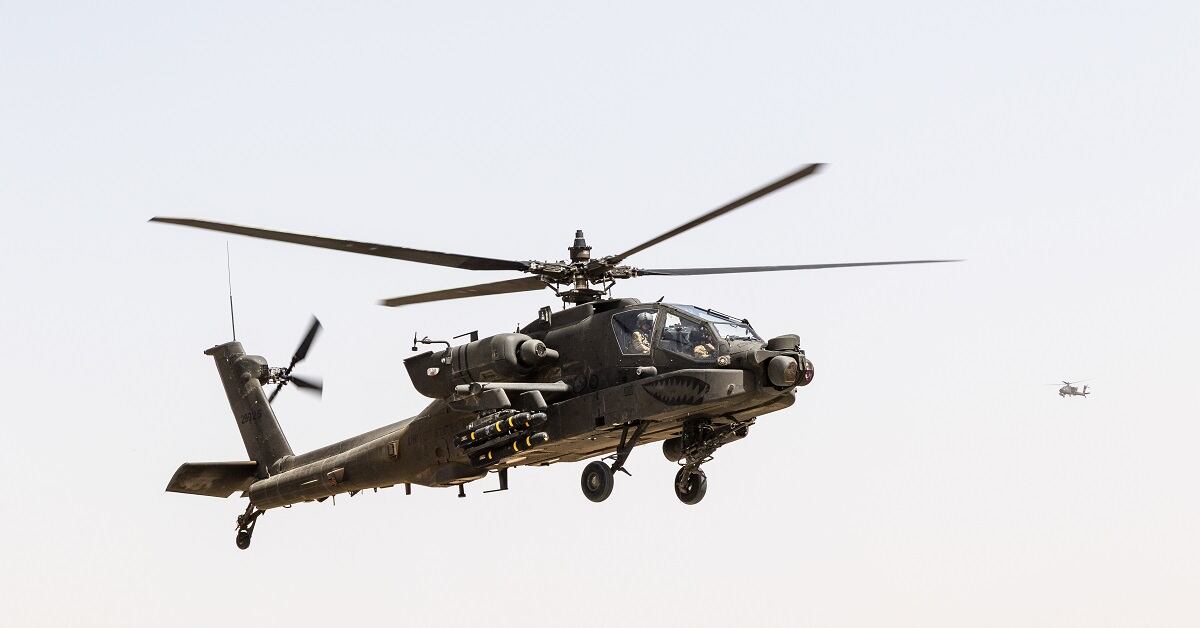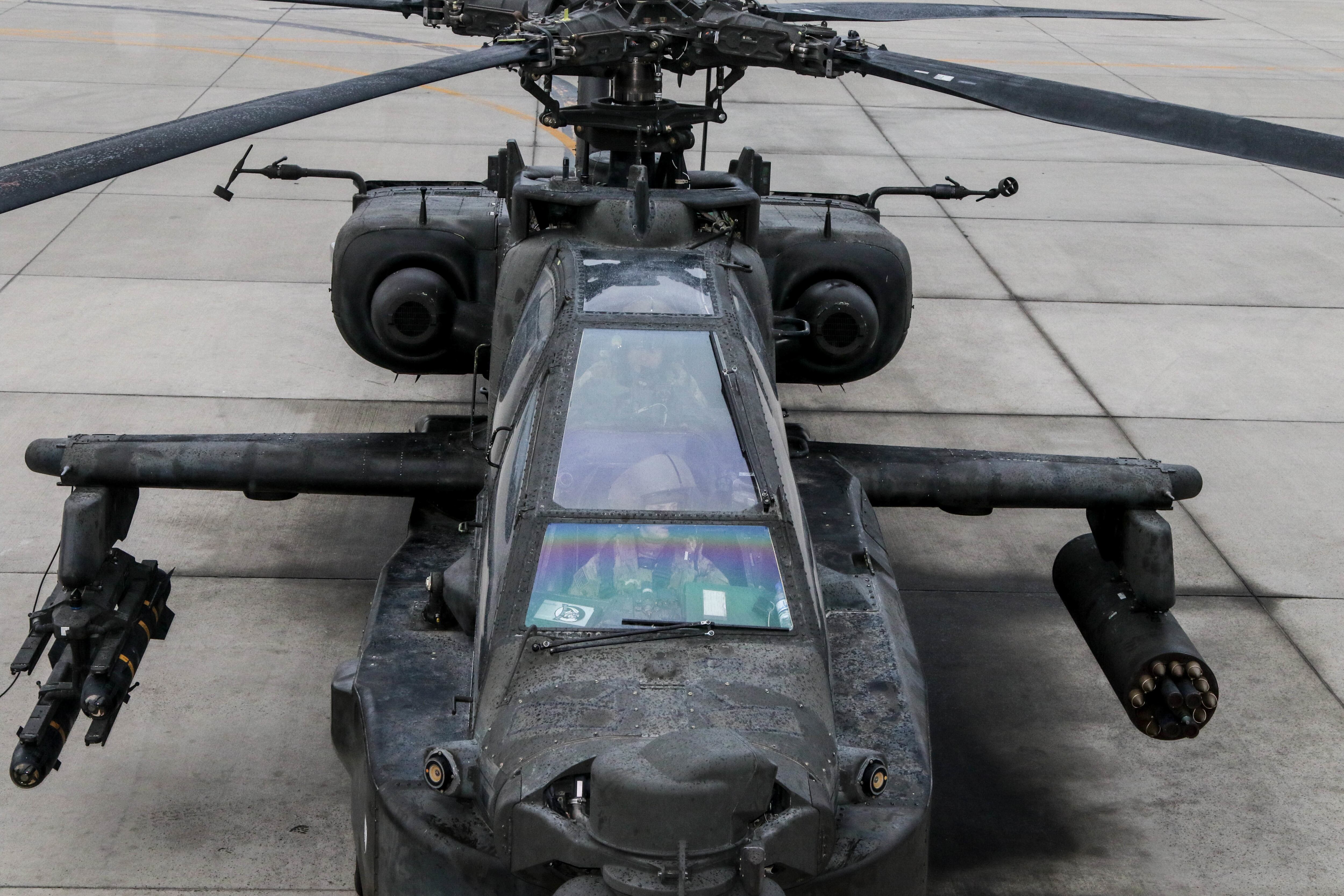Despite years of attempts to address the problem, the Army is struggling to deal with a shortage of about 700 pilots, a persistent manpower problem that could impact the readiness of the entire force.
Two years ago, the head of Army aviation told lawmakers that the Army was grappling with a hole in its warrant officer corps ― 731 pilots at the time ― and said the Army would tackle the problem through recruiting efforts, increasing seats at training schools and an aggressive push to retain seasoned aviators.
But in the two years since then, the Army has only added about 30 pilots, and has nearly 700 left to fill, according to data provided to Army Times.
Army pilots are concerned about mission readiness levels that are compromised and even misreported, the increased risk for aviation mishaps, and competing priorities that are “breaking pilots,” a senior pilot told Army Times.

Top officials acknowledge that filling the pilot shortage is not easy and can take a long time.
“Our forecast is, once you get additional manning, it’s about six years before you’ve totally trained everybody,” Maj. Gen. William Gayler, the Aviation Center of Excellence’s then-commander, told an audience just outside Washington, D.C. last fall.
“You know, it took us a decade to get in this position. We can’t get out of it within the year or by next Thursday, so we’ve got some work ahead of us.”
Nevertheless, Gayler said that the organization had made real progress, particularly in filling out the ranks of more junior pilots, taking some pressure off of the seniors to do those jobs.
Currently, the aviation community as a whole is manned to 105 percent for pilots, according to Army data. In the active Army, that number is 103 percent, with 119 percent of commissioned officers required and 93 percent of warrants.
But those numbers are misleading.

“Although the numbers appear positive in aggregate, there exists an imbalance between a surplus of senior aviators and a shortage of nearly 700 junior aviators across the three components from required manning levels,” Army spokesman Matthew Leonard told Army Times in a statement.
The Army might have netted a few dozen additional aviators over the past couple of years, but that doesn’t account for the real numbers of mission-ready flight crews, according to the senior pilot.
“I have the appropriate number of people, if you just look at my company on paper,” the chief warrant officer 3, who asked not to be named for fear of reprisal, told Army Times of his unit in a combat aviation brigade.
For each of his 10 helicopters, he said, he needs a qualified “pilot in command” to man it.
“But I have currently, in my unit, as of two days from now, five pilots in command who are eligible to fly," he said.
In general, the Army aims to man its units at more than 100 percent to account for changes in availability for soldiers who are injured, dealing with personal issues or temporarily reassigned to schools or other duties.
“While the Army is experiencing some shortages across its aviation force, the pilots and aircraft that are available in aviation units are training to high levels of readiness and will continue to do so,"Leonard said. “Impacts downrange are mitigated by prioritizing deploying units for manning and equipping to ensure those units are fully ready.”
But to say that the shortage of warrant officers is improving would be ignorant at best, the pilot said, and a “bald-faced lie at worst.”
His combat aviation brigade, for example, was rated “critical” for readiness in a recent Aviation Resource Management survey, he said, but the Army would not confirm that.
“Readiness ratings are sensitive and we do not disclose details of inspection findings or the subsequent remedial training performed,” Leonard said.
But “thorough and deliberate” deployment training is meant to bring units up to the highest level of readiness before they go abroad.

That remedial training is meant to fill in the gaps for pilots who fly crucial insertion and extraction missions, medical evacuation flights and re-supplies for troops downrange.
But a dip in proficiency can mean life or death, beyond the quality of service frustrations of individual pilots, and a great number of military aviation mishaps are blamed on pilot error.
RELATED

“And it’s frustrating to see it, because there’s so many opportunities right now for Army aviators to get out of the Army and go work for the airlines,” the pilot said of the tension in the Army’s aviation community.
About 10 percent of the aviator force is getting out each year, according to an Army release in April, many of them to become commercial pilots.
“They have finally realized that Army aviators — albeit, we’re not fixed-wing guys — with a little bit of training, we’re really pretty good pilots," the warrant officer said. "We just have to learn how to fly that one.”
The need for experience
Increasing throughput at flight school was one of the first steps, and a relatively simple one, as leaders have said that the Army does not tend to struggle to find soldiers wanting to fly.
But keeping those aviators around long enough to become seasoned, critical instructors and senior personnel becomes the bigger challenge.
The solution on offer is retention bonuses. They are targeted at junior pilots with between six to 13 years in service and senior warrants with between 19 and 22 years, pinpointing the times when aviators are most likely to get out ― after they’re finished with their active-duty service obligations and moving into more mid-level roles with higher administrative burdens, as well as when they first become eligible for retirement.
The Army took its guidance from the Office of Economic and Manpower Analysis at West Point when it decided which groups would be best suited for bonuses.
“OEMA’s analysis also shows that, on average, 70 percent of warrant officers who stay in for 10 years of service will stay until 13 years of service, which makes targeting those with no more than 13 years of [active federal service] crucial to bridge the retention gap and carry the population through the 15- to 18-years-of-AFS mark,” Leonard said.
The AH-64 Apache, CH-47 Chinook and fixed-wing communities can take advantage of a three-year extension at $35,000 a year, or $30,000 for UH-60 Black Hawks.

Since the bonus debuted in October 2017, Leonard said, there’s been a 49 percent take rate, between 55 percent for Apaches and 43 percent for Black Hawks.
It was designed to “help bridge the shortage gap which has grown over the past decade due to under-production of pilots in flight school,” Leonard said.
More than 500 have graduated so far this year, according to Army data, and almost 1,000 did last year. The hope is to increase that to 1,272 a year, Leonard added, which would get the aviation warrant officer corps to 95 percent manning by 2024.
Currently, there are about 14,000 pilots in the active and reserve components.

First hike in incentive pay in 20 years
Soon, the Army plans to bump up Aviation Incentive Pay for the first time since 1999.
It would increase a 14-year warrant officer from $840 a month to $1000, Leonard said, adding that $1000 is the maximum, per the 2017 National Defense Authorization Act.
“All of these are just levers to try to retain people,” Gayler told an audience in April at the Army Aviation Association of America symposium. “The single most important will probably be to pay them for what their skills require. That’s a tough thing to do right now, when money is a challenge and we have to prioritize for other things, but we’ve got to find ways to keep them.”
But even so, according to a 2018 Government Accountability Office study of the Air Force, Navy and Marine Corps’ pilot retention issues, the Defense Department doesn’t track whether airlines are, in fact, poaching seasoned pilots, and whether retention bonuses are keeping them from taking those jobs.
“[DoD] has noted projected increases in airline hiring when justifying increases to aviation retention bonuses,” according to the findings. “However, DoD does not have data on the number of pilots leaving the military to accept jobs as airline pilots because, according to service officials, the services do not have mechanisms to capture these data.”
GAO recommended that those three services refine their exit surveys to specifically ask what type of job the service members are leaving to pursue, and the services concurred with the findings.

Morale issues
Money can be a powerful incentive, but it’s not the only one, the senior pilot said.
“Guys are not leaving because of money,” the pilot said. “Guys that took the bonus were staying anyway.”
Job satisfaction among warrants is also suffering, and a bonus doesn’t necessarily make up for it, he said.
“The overarching desires of the Department of the Army shadow the reality of requirements needed to maintain proficiency and safe operations in an entity as in-depth as Army aviation,” a group of anonymous pilots wrote in a letter that circulated through military aviation online forums and email groups earlier this year.
While congressional hearings on the issues are a “step in the right direction,” they wrote, “the common consensus of Army aviators is that our leadership did not represent, or correctly articulate, the overwhelming issues that blanket Army aviation.”
No. 1, according to the letter, is that aviation is low on the Army’s list of priorities when compared to the service’s expansive mission set.
“The common verbiage associated with this is that we’re 'Soldiers first, Officers second, Aviators Third,” they wrote, and flying often takes a back seat when there’s a manning shortfall. Officers are finding themselves doing administrative, supply or armory work instead.
There are two tracks for aviators in the Army, either as a commissioned officer or a warrant officer. Commissioned officers follow a career track similar to their peers in other branches, starting out at the small-unit level ― in this case, flying and leading a crew ― and then moving up in responsibility, while rotating through staff or joint jobs along the way.
Warrant officers, though they rise in rank and responsibility, are considered technical experts, and they’ll fly helicopters the whole way through. Spending time on anything else is not only “not what we signed up for,” pilots say, but is a distraction to the training and focus required to do their high-risk jobs.
“We’re not ‘at war’ the way we were years ago,” the pilot said. “These commanders that do not get wartime command feel that they must validate themselves with hard training.”
To their credit, he added, they’re following guidance from Army Chief of Staff Gen. Mark Milley, who has been pushing the concept of austere environments in future warfare.
Last year, in a proof-of-concept exercise in Romania, his unit went into the forest with three helicopters and covered them in camouflage netting, the pilots painting their faces, to rehearse what it would be like to conceal themselves in that environment.
"I heard my battalion commander say, ‘When we hit the ground, we’re all infantry.’ And the infantry brigade commander said, ‘Hey, how about you be good at aviation and I’ll be good at infantry?’, " the pilot said. “As if to say, the infantry doesn’t want us to be infantry. The infantry doesn’t care that I can carry a 60-pound rucksack for 12 miles, because that’s their job.”
It all adds up to a drop in readiness, he said. Less time focused on flying directly contributes the Army’s aviation mishap numbers, he added.
RELATED

“We are wasting time, breaking soldiers, breaking pilots, doing these things,” he said. “If I have to be good at the ground stuff, that means I’m not good at my aviation stuff.”
And there’s denial about how bad the issue is, according to the letter.
“With a projected one-third of aviators retirement eligible in the near future, concerns are yet to be brought up about our future,” they wrote. “Readiness slides are sent up fudging numbers to appease the chain of command. This reporting has been lied about for years, and nothing continues to be done.”
Rather than showing mission-capable rates, they added, literal manning numbers are passed off as readiness.
The Army is aware of the community’s disillusionment, Leonard said, and “actively engaging” with pilots to address their quality of life issues.
“Aside from continuing to offer the aviation bonus, the Army offers aviators assignment tour length extensions and assignment of choice whenever feasible to provide family stability,” he said.
Your mileage may vary, the pilot said, as his most recent permanent change of station wasn’t on his wish list at all.
“The Army is also offering additional skilled training, such as instructor pilot courses; increasing the number of personnel briefings and improving communications practices from Army Human Resources Command to better inform pilots; and stressing the importance of positive command climates," Leonard said.
Easier said than done, the pilot said. He would have liked to get fixed-wing qualified, he said, which the Army used to offer in exchange for a five-year service obligation.
But they don’t offer it to helicopter pilots anymore. That training would have kept him in the Army, he said, while helping prepare him for a civilian career.
“All I would like is, I would like, one, for the Army to own that we have a very serious problem that they don’t know how to fix,” he said. “At 15 years, three kids ― it’s not worth it to stay, because the Army’s not serious about fixing the problem."
Meghann Myers is the Pentagon bureau chief at Military Times. She covers operations, policy, personnel, leadership and other issues affecting service members.





